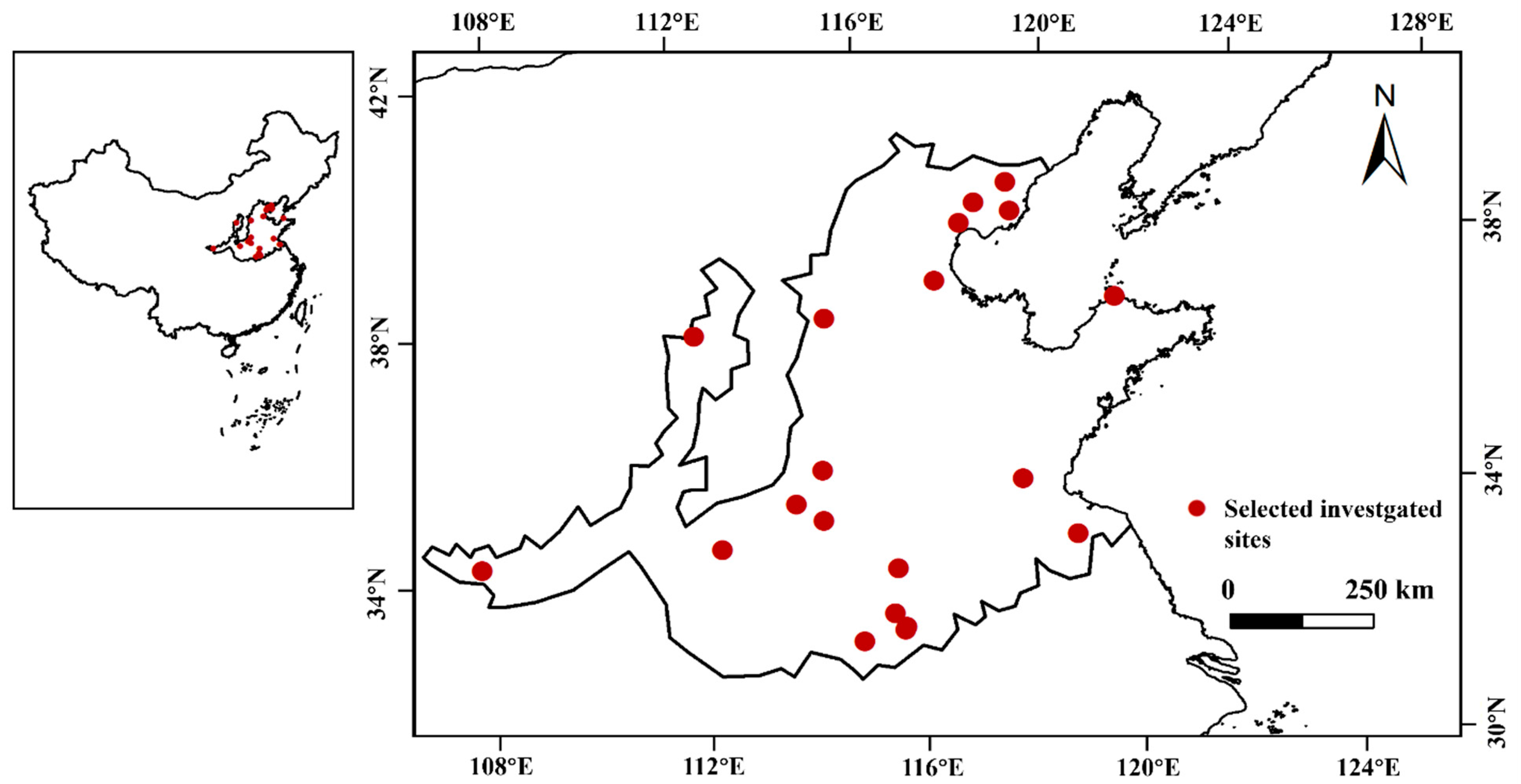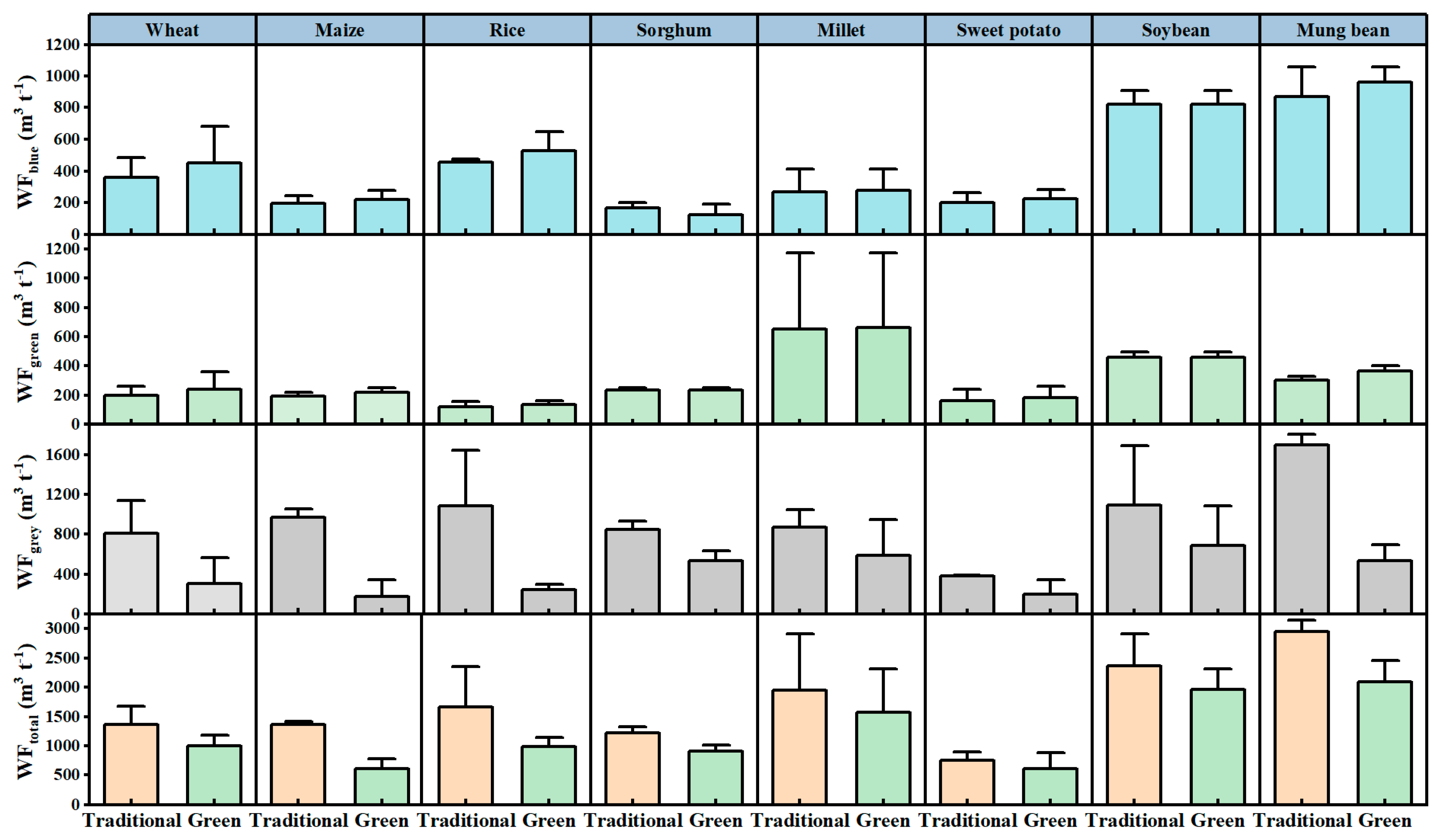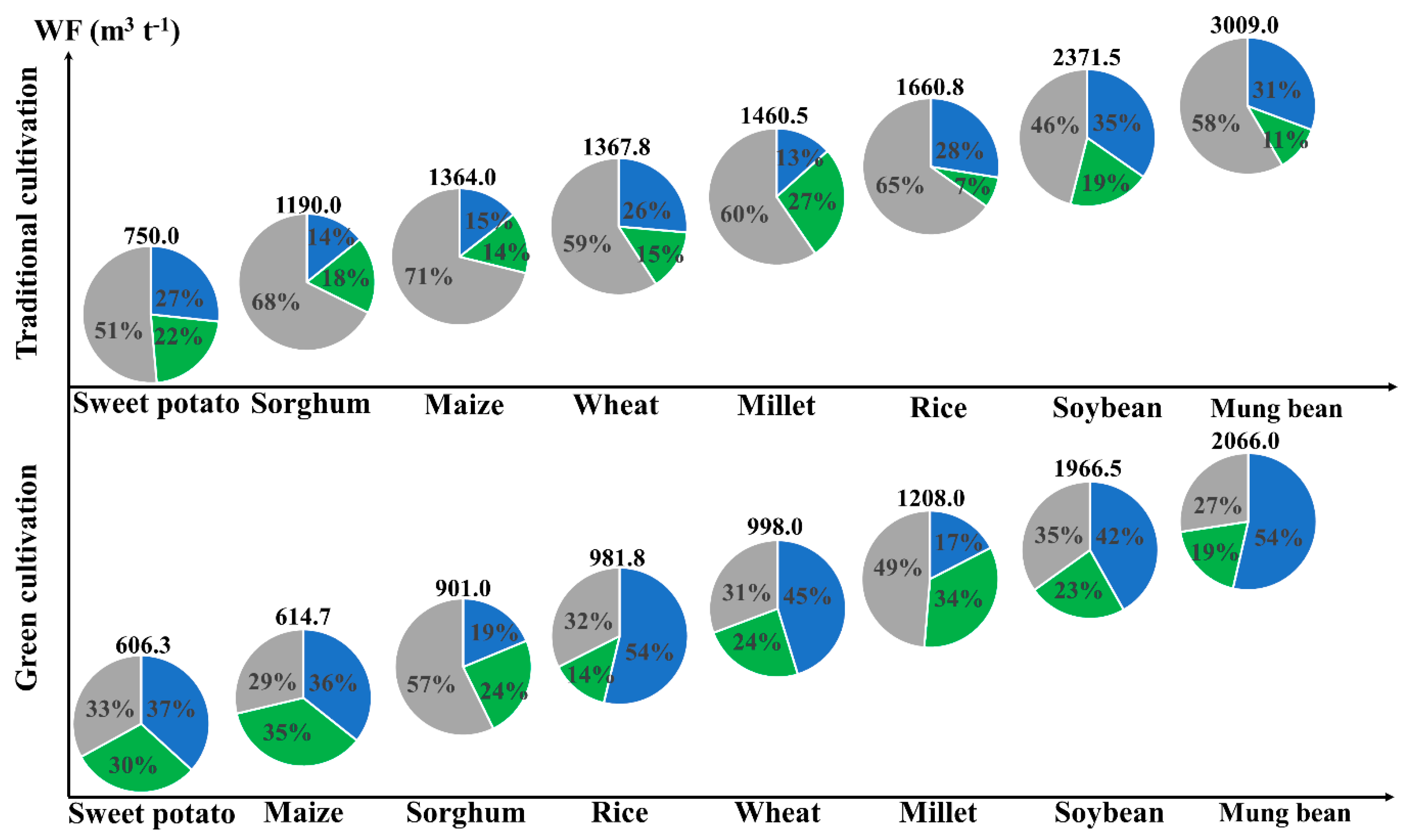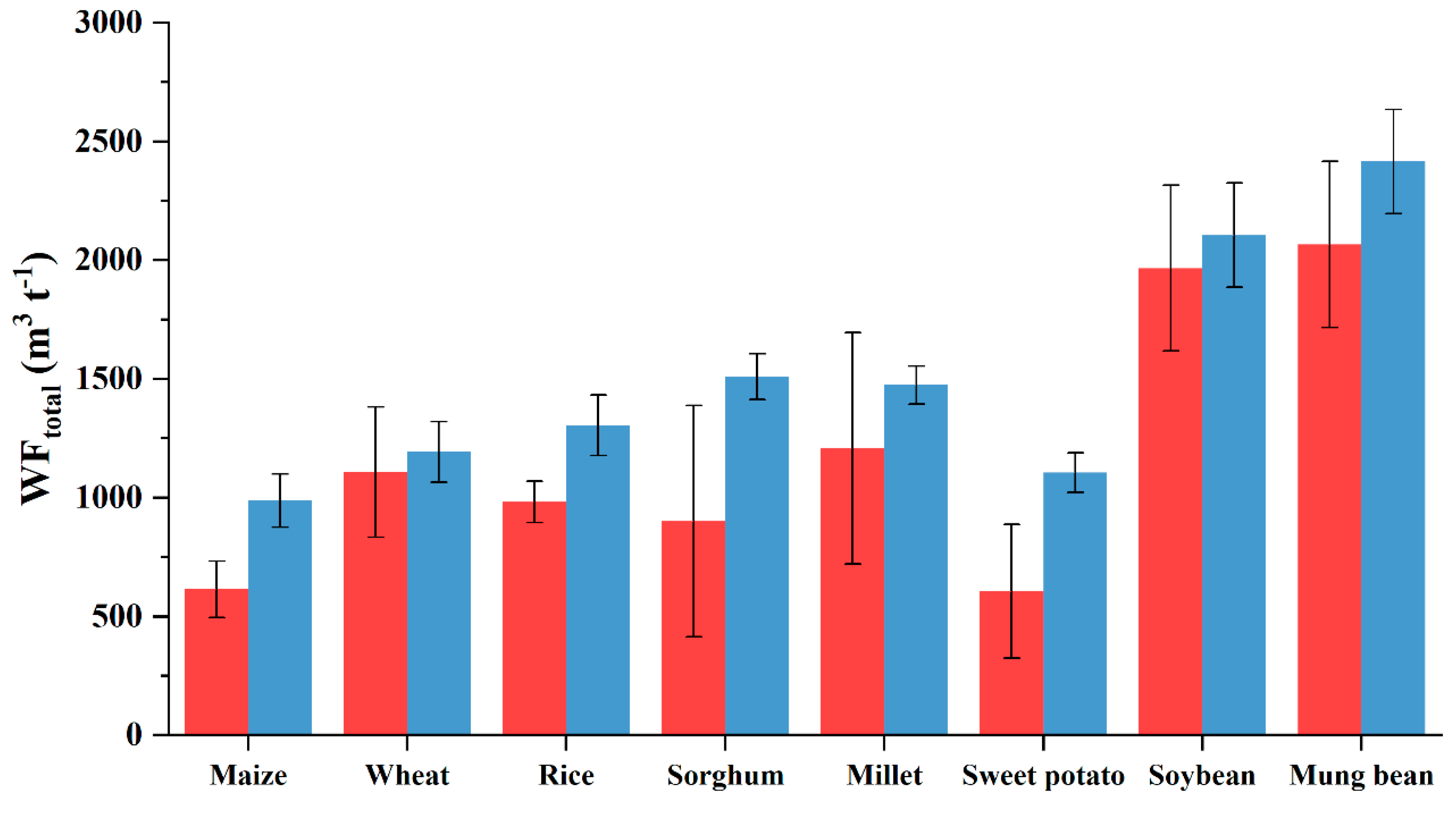Water Footprint Assessment of Green and Traditional Cultivation of Crops in the Huang-Huai-Hai Farming Region
Abstract
1. Introduction
2. Materials and Methods
2.1. Study Area
2.2. Data Source
2.3. Water Footprint Calculations
- (1)
- Calculation of ETc and ETaw based on the SIMETAW model
- (2)
- Crop water footprint calculation
3. Results
3.1. Water Requirements and Yield for Green and Traditional Crop Cultivation
3.2. Comparison of Crop Water Footprint between Green and Traditional Cultivation Crops
3.3. Water Footprint Composition of Green and Traditional Cultivation Crops
4. Discussion
4.1. Water Requirements and Yield under Green and Traditional Cultivation Crops
4.2. Water Footprints under Green and Traditional Cultivation Crops
4.3. Implication for Green Cultivation
5. Conclusions
Supplementary Materials
Author Contributions
Funding
Data Availability Statement
Conflicts of Interest
References
- Li, Y.X.; Zhang, W.F.; Ma, L.; Wu, L.; Shen, J.B.; Davies, W.J.; Oenema, O.; Zhang, F.S.; Dou, Z.X. An analysis of China’s grain production: Looking back and looking forward. Food Energy Secur. 2014, 3, 19–32. [Google Scholar] [CrossRef]
- D’Odorico, P.; Davis, K.F.; Rosa, L.; Carr, J.A.; Chiarelli, D.; Dell’Angelo, J.; Gephart, J.; MacDonald, G.K.; Seekell, D.A.; Suweis, S.; et al. The global food-energy-water nexus. Rev. Geophys. 2018, 56, 456–531. [Google Scholar] [CrossRef]
- Yang, X.L.; Wang, G.Y.; Chen, Y.Q.; Sui, P.; Pacenka, S.; Steenhuis, T.S.; Siddique, K.H.M. Reduced groundwater use and increased grain production by optimized irrigation scheduling in winter wheat–summer maize double cropping system—A 16-year field study in North China Plain. Field Crop Res. 2022, 275, 108364. [Google Scholar] [CrossRef]
- Xu, Z.; Chen, X.; Liu, J.; Zhang, Y.; Chau, S.; Bhattarai, N.; Wang, Y.; Li, Y.; Connor, T.; Li, Y. Impacts of irrigated agriculture on food-energy-water-CO2 nexus across metacoupled systems. Nat. Commun. 2020, 11, 5837. [Google Scholar] [CrossRef] [PubMed]
- Yu, C.Q.; Huang, X.; Chen, H.; Godfray, H.C.J.; Wright, J.S.; Hall, J.W.; Gong, P.; Ni, S.Q.; Qiao, S.C.; Huang, G.R.; et al. Managing nitrogen to restore water quality in China. Nature 2019, 567, 516–520. [Google Scholar] [CrossRef] [PubMed]
- Guo, J.H.; Liu, X.J.; Zhang, Y.; Shen, J.L.; Han, W.X.; Zhang, W.F.; Cristie, P.; Goulding, K.W.T.; Vitousek, P.M.; Zhang, F.S. Significant acidification in major Chinese croplands. Science 2010, 327, 1008–1010. [Google Scholar] [CrossRef]
- Li, A.; Strokal, M.; Bai, Z.; Kroeze, C.; Ma, L. How to avoid coastal eutrophication—A back-casting study for the North China Plain. Sci. Total Environ. 2019, 692, 676–690. [Google Scholar] [CrossRef]
- Gu, B.J.; Ge, Y.; Chang, S.X.; Luo, W.D.; Chang, J. Nitrate in groundwater of China: Sources and driving forces. Global Environ. Change 2013, 23, 1112–1121. [Google Scholar] [CrossRef]
- Sanders, R. A Market Road to Sustainable Agriculture? Ecological Agriculture, Green Food and Organic Agriculture in China. Dev. Change 2006, 37, 201–226. [Google Scholar] [CrossRef]
- Hassan, M.u.; Zhong, J.H.; Xu, J.L.; Wen, X.; Li, X.X. Development and challenges of green food in China. Front. Agric. Sci. Eng. 2020, 7, 56. [Google Scholar] [CrossRef]
- Boye, J.I.; Arcand, Y. Current trends in green technologies in food production and processing. Food Eng. Rev. 2013, 5, 1–17. [Google Scholar] [CrossRef]
- China Green Food Development Center (CGFDC). Interpretation of Green Food Production Materials; CGFDC: Beijing, China, 2014. [Google Scholar]
- China Green Food Development Center (CGFDC). Green Food Statistical Yearbook; CGFDC: Beijing, China, 2017. [Google Scholar]
- The State Council Information Office. Key Points of No. 1 Central Document; The State Council Information Office: Beijing, China, 2021.
- Liu, X.H.; Chen, F. Farming Systems in China; China Agriculture Press: Beijing, China, 2005. [Google Scholar]
- National Bureau of Statistics of China. China Statistical Yearbook; China Statistics Press: Beijing, China, 2021. [Google Scholar]
- Kong, X.B.; Zhang, X.L.; Lal, R.; Zhang, F.R.; Chen, X.H.; Niu, Z.G.; Han, L.; Song, W. Groundwater depletion by agricultural intensification in China’s HHH Plains, since 1980s. Adv. Agron. 2016, 135, 59–106. [Google Scholar] [CrossRef]
- Liu, M.; Min, L.; Wu, L.; Pei, H.; Shen, Y. Evaluating nitrate transport and accumulation in the deep vadose zone of the intensive agricultural region, North China Plain. Sci. Total Environ. 2022, 825, 153894. [Google Scholar] [CrossRef] [PubMed]
- Wang, F.F.; Wang, Y.H.; Cai, Z.C.; Chen, X. Environmental losses and driving forces of nitrogen flow in two agricultural towns of Hebei province during 1997-2017. Environ. Pollut. 2020, 264, 114636. [Google Scholar] [CrossRef] [PubMed]
- Liu, Y.F.; Sun, D.S.; Wang, H.J.; Wang, X.J.; Yu, G.Q.; Zhao, X.J. An evaluation of China’s agricultural green production: 1978–2017. J. Clean. Prod. 2020, 243, 118483. [Google Scholar] [CrossRef]
- Lin, L.; Zhou, D.Y.; Ma, C.X. Green food industry in China: Development, problems and policies. Renew. Agric. Food Syst. 2010, 25, 69–80. [Google Scholar] [CrossRef]
- China Green Food Development Center (CGFDC). Green Food Statistical Yearbook; CGFDC: Beijing, China, 2021. [Google Scholar]
- Hoekstra, A.Y. Water scarcity in the zambezi basin in the long-term future: A risk assessment. Integr. Assess. 2003, 4, 185–204. [Google Scholar] [CrossRef]
- Sun, S.; Wu, P.; Wang, Y.; Zhao, X.; Liu, J.; Zhang, X. The impacts of interannual climate variability and agricultural inputs on water footprint of crop production in an irrigation district of China. Sci. Total Environ. 2013, 444, 498–507. [Google Scholar] [CrossRef]
- Mekonnen, M.M.; Hoekstra, A.Y. The green, blue and grey water footprint of crops and derived crop products. Hydrol. Earth. Syst. Sci. 2011, 15, 1577–1600. [Google Scholar] [CrossRef]
- Tuninetti, M.; Tamea, S.; D’Odorico, P.; Laio, F.; Ridolfi, L. Global sensitivity of high-resolution estimates of crop water footprint. Water Resour. Res. 2015, 51, 8257–8272. [Google Scholar] [CrossRef]
- Zhang, L.L. Effects of Organic Material Returning on Carbon, Nitrogen and Water Footprint, Ecological Service Value of Winter Wheat; Henan Normal University: Henan, China, 2017. [Google Scholar]
- Hoekstra, A.Y.; Chapagain, A.K.; Aldaya, M.M.; Mekonnen, M.M. The Water Footprint Assessment Manual: Setting the Global Standard; Earthscan: London, UK, 2011. [Google Scholar]
- Su, M.H.; Huang, C.H.; Li, W.Y.; Tso, C.T.; Lur, H.S. Water footprint analysis of bioethanol energy crops in Taiwan. J. Clean. Prod. 2015, 88, 132–138. [Google Scholar] [CrossRef]
- Mohammad, B.; Tim, H.; Heather, S.; Sophie, U.; Joseph, G.J. Value propositions of the water footprint concept for sustainable water utilities. J. Am.Water Work Assoc. 2017, 109, 393–408. [Google Scholar] [CrossRef]
- Luan, X.B.; Wu, P.T.; Sun, S.K.; Wang, Y.B.; Gao, X.R. Quantitative study of the crop production water footprint using the SWAT model. Ecol. Indic. 2018, 89, 1–10. [Google Scholar] [CrossRef]
- Hossain, I.; Imteaz, M.A.; Khastagir, A. Water footprint: Applying the water footprint assessment method to Australian agriculture. J. Sci. Food Agric. 2021, 101, 4090–4098. [Google Scholar] [CrossRef]
- Rajakal, J.P.; Ng, D.K.S.; Tan, R.R.; Andiappan, V.; Wan, Y.K. Multi-objective expansion analysis for sustainable agro-industrial value chains based on profit, carbon and water footprint. J. Clean. Prod. 2021, 288, 125117. [Google Scholar] [CrossRef]
- Wang, Y.B.; Wu, P.T.; Engel, B.A.; Sun, S.K. Application of water footprint combined with a unified virtual crop pattern to evaluate crop water productivity in grain production in China. Sci. Total Environ. 2014, 497–498, 1–9. [Google Scholar] [CrossRef]
- Huang, J.; Zhang, H.-L.; Tong, W.-J.; Chen, F. The impact of local crops consumption on the water resources in Beijing. J. Clean. Prod. 2012, 21, 45–50. [Google Scholar] [CrossRef]
- Borsato, E.; Galindo, A.; Tarolli, P.; Sartori, L.; Marinello, F. Evaluation of the grey water footprint comparing the indirect effects of different agricultural practices. Sustainability 2018, 10, 3992. [Google Scholar] [CrossRef]
- Vale, R.L.; Netto, A.M.; Toríbio de Lima Xavier, B.; de Lâvor Paes Barreto, M.; Siqueira da Silva, J.P. Assessment of the gray water footprint of the pesticide mixture in a soil cultivated with sugarcane in the northern area of the State of Pernambuco, Brazil. J. Clean. Prod. 2019, 234, 925–932. [Google Scholar] [CrossRef]
- Snyder, R.L.; Geng, S.; Orang, M.N.; Matyac, J.S. A simulation model for ET of applied water. Acta Horticult. 2004, 664, 623–629. [Google Scholar] [CrossRef]
- Snyder, R.L.; Orang, M.N.; Matyac, S.G.J.S.; Sarreshteh, S. SIMETAW (Simulation of Evapotranspiration of Applied Water). Calif. Water Plan Update 2005, 4, 211–226. [Google Scholar]
- Snyder, R.L.; Geng, S.; Orang, M.; Sarreshteh, S. Calculation and simulation of evapotranspiration of applied water. J. Integr. Agric. 2012, 11, 489–501. [Google Scholar] [CrossRef]
- Kong, Q.X.; Zhang, H.L.; Chen, F.; Song, Z.W. Estimation of main crop water requirement in Beijing based on SIMETAW model. J. Chin. Agric. Univ. 2009, 14, 109–115. [Google Scholar]
- Yang, X.L.; Huang, J.; Chen, F.; Chu, Q.Q. Comparison of temporal and spatial variation of water requirements of corn in Huang-huai-hai. J. Chin. Agric. Univ. 2011, 16, 26–31. [Google Scholar]
- Yang, X.L.; Gao, W.S.; Shi, Q.H.; Chen, F.; Chu, Q.Q. Impact of climate change on the water requirement of summer maize in the Huang-Huai-Hai farming region. Agric. Water Manag. 2013, 124, 20–27. [Google Scholar] [CrossRef]
- Yang, X.L.; Liang, F.T.; Yan, J.P.; Chen, Y.Q.; Jia, X.L. Research on water requirements of diversified crop rotations in the middle and southern areas of Hebei Province. J. Chin. Agric. Univ. 2021, 26, 01–17. [Google Scholar]
- Hu, S.; Mo, X.G.; Lin, Z.H. Influence of possible changes in winter wheat planting regions on the profit and loss of agricultural water resources in the Huang-Huai-Hai region. Geogr. Res. 2017, 36, 861–871. [Google Scholar] [CrossRef]
- Jia, H.; Zhang, T.; Yin, X.G.; Shang, M.F.; Chen, F.; Lei, Y.D.; Chu, Q.Q. Impact of climate change on the water requirements of oat in Northeast and North China. Water 2019, 11, 91. [Google Scholar] [CrossRef]
- Allen, R.G.; Pereira, L.S.; Raes, D.; Smith, G. Crop Evapotranspiration—Guidelines for Computing Crop Water Requirements—FAO Irrigation and Drainage Paper 24; Food and Agriculture Organization of the United Nations: Rome, Italy, 1998. [Google Scholar]
- Doorenbos, J.; Pruitt, W.O. Crop Water Requirements—FAO Irrigation and Drainage Paper 56; Food and Agriculture Oragnization of the United Nations: Rome, Italy, 1977. [Google Scholar]
- Allen, R.G.; Walter, I.A.; Elliott, R.L.; Howell, T.; Itenfisu, D.; Jensen, M.E. The ASCE Standardized Reference Evapotranspiration Equation; University of Idaho: Moscow, ID, USA, 2005. [Google Scholar]
- Chapagain, A.K.; Hoekstra, A.Y. The blue, green and grey water footprint of rice from production and consumption perspectives. Ecol. Indic. 2011, 70, 749–758. [Google Scholar] [CrossRef]
- Wang, D.Y.; Li, J.B.; Ya, Y.Y.; Tan, F.F. An improved calculation method of grey water footprint. Int. J. Agric. Nat. Res. 2015, 30, 2120–2130. [Google Scholar]
- Wang, S.; Fu, G.; Ma, X.; Xu, L.; Yang, F. Exploring the optimal crop planting structure to balance water saving, food security and incomes under the spatiotemporal heterogeneity of the agricultural climate. J. Environ. Manag. 2021, 295, 113130. [Google Scholar] [CrossRef] [PubMed]
- Yang, F.; Zhang, S.S.; Song, J.P.; Du, Q.; Li, G.X.; Tarakina, N.V.; Antonietti, M. Synthetic humic acids solubilize otherwise insoluble phosphates to improve soil fertility. Angew. Chem. Int. Ed. Engl. 2019, 58, 18813–18816. [Google Scholar] [CrossRef] [PubMed]
- Wang, J.; Qin, L.; Cheng, J.; Shang, C.; Li, B.; Dang, Y.; He, H. Suitable chemical fertilizer reduction mitigates the water footprint of maize production: Evidence from Northeast China. Environ. Sci. Pollut. Res. Int. 2022, 29, 22589–22601. [Google Scholar] [CrossRef] [PubMed]
- Chapagain, A.K.; Hoekstra, A.Y. The blue, green and grey water footprint of rice from production and consumption perspectives. Ecol. Econ. 2011, 70, 749–758. [Google Scholar] [CrossRef]
- Yang, H.; Liu, L.J.; Liu, Z.J.; Shang, W.Q.; Qu, X.J. Analysis and suggestions of agricultural fertilizer application in China. J. Agr. Mech. Res. 2014, 36, 260–264. [Google Scholar] [CrossRef]
- Zhang, Y.; Li, Y.K.; Ouyang, Z.Y.; Liu, J.G. The grey water footprint of the winter wheat-summer mazie crop rotation system of the North China Plain. Acta. Ecol. Sin. 2015, 35, 6647–6654. [Google Scholar]
- Yang, W.X. Influencing Factors and Estimation of Nitrogen and Phosphorus from Farmlands in China; Nanjing Agricultural University: Nanjing, China, 2015. [Google Scholar]
- Liu, C.; Kroeze, C.; Hoekstra, A.Y.; Gerbens-Leenes, W. Past and future trends in grey water footprints of anthropogenic nitrogen and phosphorus inputs to major world rivers. Ecol. Indic. 2012, 18, 42–49. [Google Scholar] [CrossRef]
- Liu, W.F.; Antonelli, M.; Liu, X.C.; Yang, H. Towards improvement of grey water footprint assessment: With an illustration for global maize cultivation. J. Clean. Prod. 2017, 147, 1–9. [Google Scholar] [CrossRef]
- Feng, H.; Sun, F.; Liu, Y.; Zeng, P.; Deng, L.; Che, Y. Mapping multiple water pollutants across China using the grey water footprint. Sci. Total Environ. 2021, 785, 147255. [Google Scholar] [CrossRef]
- Yu, C.; Yin, X.; Li, H.; Yang, Z. A hybrid water-quality-index and grey water footprint assessment approach for comprehensively evaluating water resources utilization considering multiple pollutants. J. Clean. Prod. 2020, 248, 119225. [Google Scholar] [CrossRef]
- Zhao, Y.X.; Wang, L.; Lei, X.Y.; Wang, B.; Cui, J.X.; Xu, Y.N.; Chen, Y.Q.; Sui, P. Reducing carbon footprint without compromising grain security through relaxing cropping rotation system in the North China Plain. J. Clean. Prod. 2021, 318, 128465. [Google Scholar] [CrossRef]
- Han, Y.P.; Qu, C.; Jia, D.D. Analysis of water footprint and water consumption structure of major crops in Hebei province. J. Irrig. Drain. 2019, 38, 121–128. [Google Scholar] [CrossRef]
- Zhang, K.; Zhou, J.; Zhao, J.; Pei, K.; Wang, Z.M.; Hu, Y.G.; Zeng, Z.H. Agricultural groundwater footprint of the major cropping system in the North China Plain: A case study of Wuqiao County, Hebei Province. J. Chin. Agric. Univ. 2020, 25, 328–336. [Google Scholar] [CrossRef]
- Xie, P.X. Estimating Blue and Green Water Resources, Water Footprints and Water Scarcities in the Yellow River Basin; Northwest A&F University: Yangling, China, 2020. [Google Scholar]
- Dai, C.; Qin, X.S.; Lu, W.T. A fuzzy fractional programming model for optimizing water footprint of crop planting and trading in the Hai River Basin, China. J. Clean. Prod. 2021, 278, 123196. [Google Scholar] [CrossRef]
- Ren, P.P.; Huang, F.; Li, B.G. Spatiotemporal patterns of water consumption and irrigation requirements of wheat-maize in the Huang-Huai-Hai Plain, China and options of their reduction. Agric. Water Manag. 2022, 263, 107468. [Google Scholar] [CrossRef]
- Yan, Z.X.; Gao, C.; Ren, Y.J.; Zong, R.; Ma, Y.Z.; Li, Q.Q. Effects of pre-sowing irrigation and straw mulching on the grain yield and water use efficiency of summer maize in the North China Plain. Agric. Water Manag. 2017, 186, 21–28. [Google Scholar] [CrossRef]
- Paredes, P.; Wei, Z.; Liu, Y.; Xu, D.; Xin, Y.; Zhang, B.; Pereira, L.S. Performance assessment of the FAO AquaCrop model for soil water, soil evaporation, biomass and yield of soybeans in North China Plain. Agric. Water Manag. 2015, 152, 57–71. [Google Scholar] [CrossRef]
- Antošovský, J.; Prudil, M.; Gruber, M.; Ryant, P. Comparison of two different management practices under organic farming system. Agronomy 2021, 11, 1466. [Google Scholar] [CrossRef]
- Ponti, T.; Rijk, B.; van Ittersum, M.K. The crop yield gap between organic and conventional agriculture. Agric. Syst. 2012, 108, 1–9. [Google Scholar] [CrossRef]
- Ponisio, L.C.; M’Gonigle, L.K.; Mace, K.C.; Palomino, J.; de Valpine, P.; Kremen, C. Diversification practices reduce organic to conventional yield gap. Proc. Biol. Sci. 2015, 282, 20141396. [Google Scholar] [CrossRef]
- Seufert, V.; Ramankutty, N.; Foley, J.A. Comparing the yields of organic and conventional agriculture. Nature 2012, 485, 229–232. [Google Scholar] [CrossRef]
- Zhang, X.; Fang, Q.; Zhang, T.; Ma, W.; Velthof, G.L.; Hou, Y.; Oenema, O.; Zhang, F. Benefits and trade-offs of replacing synthetic fertilizers by animal manures in crop production in China: A meta-analysis. Glob. Change Biol. 2020, 26, 888–900. [Google Scholar] [CrossRef] [PubMed]
- Yang, X.Y.; Zhang, C.; Ma, X.L.; Liu, Q.J.; An, J.; Xu, S.J.; Xie, X.Y.; Geng, J.B. Combining organic fertilizer with controlled-release urea to reduce nitrogen leaching and promote wheat yields. Front. Plant Sci. 2021, 12, 802137. [Google Scholar] [CrossRef] [PubMed]
- Ji, L.F.; Wu, Z.D.; You, Z.M.; Yi, X.Y.; Ni, K.; Guo, S.W.; Ruan, J.Y. Effects of organic substitution for synthetic N fertilizer on soil bacterial diversity and community composition: A 10-year field trial in a tea plantation. Agric. Ecosyst. Environ. 2018, 268, 124–132. [Google Scholar] [CrossRef]
- Lu, Y.; Zhang, X.Y.; Chen, S.Y.; Shao, L.W.; Sun, H.Y. Changes in water use efficiency and water footprint in grain production over the past 35 years: A case study in the North China Plain. J. Clean. Prod. 2016, 116, 71–79. [Google Scholar] [CrossRef]
- Gheewala, S.; Silalertruksa, T.; Nilsalab, P.; Mungkung, R.; Perret, S.; Chaiyawannakarn, N. Water footprint and impact of water consumption for food, feed, fuel crops production in Thailand. Water 2014, 6, 1698–1718. [Google Scholar] [CrossRef]
- Gebremariam, F.T.; Habtu, S.; Yazew, E.; Teklu, B. The water footprint of irrigation-supplemented cotton and mung-bean crops in Northern Ethiopia. Heliyon 2021, 7, e06822. [Google Scholar] [CrossRef]
- International Fertilizer Industry Association. IFA Data. 2016. Available online: https://www.agropages.com/CompanyDirectory/Detail-10153.htm (accessed on 1 October 2019).
- Ju, X.T.; Xing, G.X.; Chen, X.P.; Zhang, S.L.; Zhang, L.J.; Liu, X.J.; Cui, Z.L.; Yin, B.; Christie, P.; Zhu, Z.L.; et al. Reducing environmental risk by improving N management in intensive Chinese agricultural systems. Proc. Natl. Acad. Sci. USA 2009, 106, 3041–3046. [Google Scholar] [CrossRef]
- Yu, X.; Gao, Z.; Zeng, Y. Willingness to pay for the “Green Food” in China. Food Policy 2014, 45, 80–87. [Google Scholar] [CrossRef]
- Jiang, Y.; Wang, H.; Jin, S.S.; Delgado, M. The promising effect of a green food label in the new online market. Sustainability 2019, 11, 796. [Google Scholar] [CrossRef]







Publisher’s Note: MDPI stays neutral with regard to jurisdictional claims in published maps and institutional affiliations. |
© 2022 by the authors. Licensee MDPI, Basel, Switzerland. This article is an open access article distributed under the terms and conditions of the Creative Commons Attribution (CC BY) license (https://creativecommons.org/licenses/by/4.0/).
Share and Cite
Xiong, J.; Liang, F.; Yang, X.; Du, T.; Pacenka, S.; Steenhuis, T.S.; Siddique, K.H.M. Water Footprint Assessment of Green and Traditional Cultivation of Crops in the Huang-Huai-Hai Farming Region. Agronomy 2022, 12, 2494. https://doi.org/10.3390/agronomy12102494
Xiong J, Liang F, Yang X, Du T, Pacenka S, Steenhuis TS, Siddique KHM. Water Footprint Assessment of Green and Traditional Cultivation of Crops in the Huang-Huai-Hai Farming Region. Agronomy. 2022; 12(10):2494. https://doi.org/10.3390/agronomy12102494
Chicago/Turabian StyleXiong, Jinran, Fangting Liang, Xiaolin Yang, Taisheng Du, Steven Pacenka, Tammo S. Steenhuis, and Kadambot H. M. Siddique. 2022. "Water Footprint Assessment of Green and Traditional Cultivation of Crops in the Huang-Huai-Hai Farming Region" Agronomy 12, no. 10: 2494. https://doi.org/10.3390/agronomy12102494
APA StyleXiong, J., Liang, F., Yang, X., Du, T., Pacenka, S., Steenhuis, T. S., & Siddique, K. H. M. (2022). Water Footprint Assessment of Green and Traditional Cultivation of Crops in the Huang-Huai-Hai Farming Region. Agronomy, 12(10), 2494. https://doi.org/10.3390/agronomy12102494









